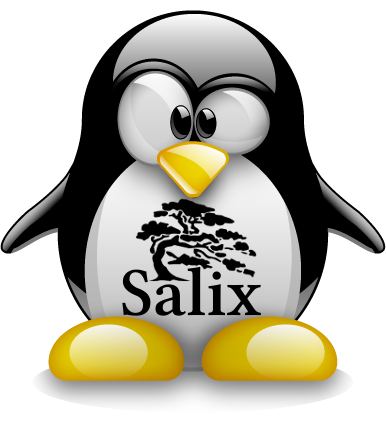 Salix OS is a Slackware-based Linux distribution that is simple, fast, easy to use and compatible with Slackware Linux.
Salix OS is a Slackware-based Linux distribution that is simple, fast, easy to use and compatible with Slackware Linux.Optimised for desktop use, Salix OS features one application per task, custom package repositories, advanced package management with dependency support, localised system administration tools and innovative artwork.
Salix OS is a Linux distribution founded by (in alphabetical order) Pierrick Le Brun, Thorsten Mühlfelder, Markus Muttilainen, Cyrille Pontvieux, Tomoki Tsuchiya and George Vlahavas.
It is based on Slackware and aims to be multi-purpose by focusing on Internet applications, multimedia and programming tools.
Additionally, Salix OS comes with some multilingual admin tools, designed for beginner through advanced users as it offers system configuration via both graphical and command-line operations.
Salix is developed by an open community of volunteers and contributors all over the world. To learn more about the people behind Salix take a look at our team page.
Updates (via Distrowatch):
George Vlahavas has announced the release of Salix OS 13.37 "LXDE" edition, a Slackware-based desktop distribution featuring the lightweight LXDE desktop environment: "Salix LXDE 13.37 has been officially released. This release is available in both 32-bit and 64-bit architectures. For everyone that has used our previous LXDE releases there are no surprises here. The application selection has stayed the same for the most part, with all applications being upgraded to newer versions. Important changes in this release are the inclusion of Sourcery, our new graphical tool for managing and installing packages from SlackBuilds, which has been developed from scratch for Salix and also the replacement of SCIM with IBus as the default input platform for Chinese, Japanese, etc."
Here is the full release announcement.
Download (MD5): salix-lxde-13.37.iso (485MB, torrent), salix64-lxde-13.37.iso (458MB, torrent).
• 2011-08-18: Distribution Release: Salix OS 13.37 "LXDE"
• 2011-07-22: Distribution Release: Salix OS 13.37 "KDE"
• 2011-06-15: Distribution Release: Salix OS 13.37 "Fluxbox"
• 2011-05-12: Distribution Release: Salix OS 13.37 "Xfce"
• 2011-02-05: Distribution Release: Salix OS 13.1.2 "Fluxbox Live"
• 2010-12-27: Distribution Release: Salix OS 13.1.2 "LXDE"
Features.
* one application per task on the installation ISO
* fully backwards compatible with Slackware
* optimized for desktop usage
* high quality package repositories with dependency support
* incredibly fast package tools
* simple & fully localized system administration tools
* nice artwork
* installation ISO fits on a single CD
* supports 32-bit and 64-bit architectures
Installation modes.
Salix has three different modes of installation:
1. Full: Everything that is included in the iso is installed. That includes the Xfce desktop environment, the Firefox web browser and Claws-mail email client, a complete OpenOffice.org office suite, a Java Runtime Environment, the Totem media player and Exaile music manager, the gslapt package manager and several other applications, always following the "one application per task" rationale.
2. Basic: This installs only the Xfce desktop environment with the Firefox web browser and the gslapt package manager. Ideal for advanced users that would like to install a lightweight Xfce and add their own choice of applications.
3. Core: Only the minimum essentials for a console system to start are included. A graphical environment is not provided. This is ideal if you are an experienced user and want to customize your installation for any specific purpose, such as a web server, file server etc.
The installation is text dialog based, but easy to navigate and complete. It is also very fast; a "full" mode installation will take less than 5 minutes on any modern PC. All three installation modes come with a complete development environment, so users don't need to add anything to start developing and compiling applications.
Screenshots.

Custom Search
If you liked this article, subscribe to the feed by clicking the image below to keep informed about new contents of the blog:















0 commenti:
Post a Comment